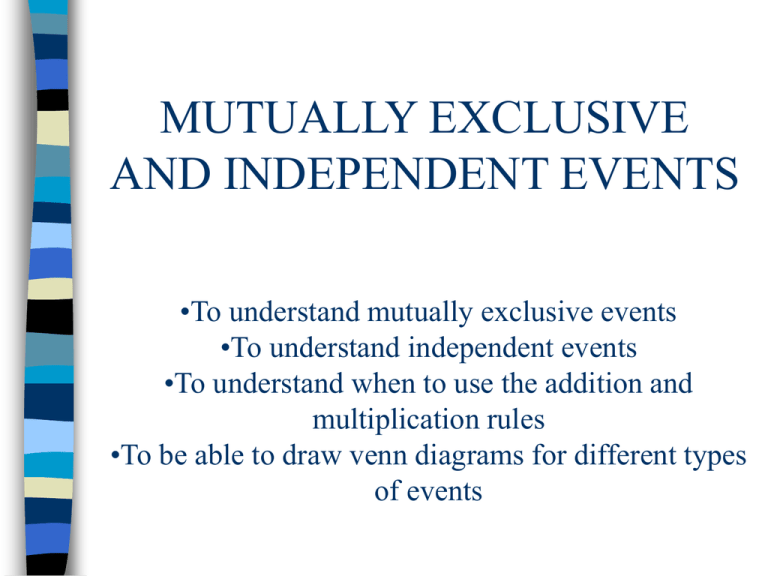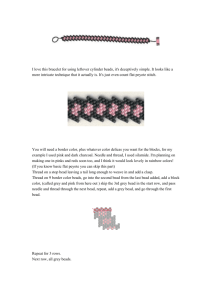S1 Mutually exclusive and independent events
advertisement

MUTUALLY EXCLUSIVE AND INDEPENDENT EVENTS •To understand mutually exclusive events •To understand independent events •To understand when to use the addition and multiplication rules •To be able to draw venn diagrams for different types of events When events have no outcomes in common they are mutually exclusive. P(A B) = 0 Using the addition rule P(AB) = P(A) + P(B) - P(A B) Since P(A B) = 0 Then P(AB) = P(A) + P(B) (The OR rule) E.G. Getting a 2 or a 3 in one roll of a dice. A B 1 6 1 6 S 4 6 When one event has no effect on another they are independent events. The probability of B happening is the same whether A has happened or not. P(A B) = P(A) x P(B) (The AND rule) E.G. Getting a 5 on a spinner numbered 1,2,3,4,5,5,7,8 and a 3 on a fair unbiased dice. A B S A red die and a blue die are rolled and the outcome of each die is recorded. A=outcome on red die is 3 B=outcome on blue die is 3 C=sum of the two dice is 5 D=the outcome on each die is the same Show that A and B are independent P(A)= 6 = 1 Red die 1 B l u e d i e 1 2 3 4 2 3 36 4 5 6 6 P(B)= 6 = 1 36 6 P(A B) = 1 x 1 = 1 6 6 36 5 This is the same as can be seen on the sample space diagram 6 Therefore A and B are independent A red die and a blue die are rolled and the outcome of each die is recorded. A=outcome on red die is 3 B=outcome on blue die is 3 C=sum of the two dice is 5 D=the outcome on each die is the same Show that C and D are mutually exclusive Red die 1 B l u e d i e 1 2 3 4 5 6 2 3 P(C) has 4 outcomes 4 5 6 P(D) has 6 outcomes They have no overlapping outcomes in common. Therefore C and D are mutually exclusive A bag contains 7 green beads and 5 blue beads. A bead is taken from the bag at random, the colour is recorded and the bead is replaced. A second bead is then taken from the bag and its colour is recorded. a) Find the probability that one bead is green and the other is blue b) Show that the event “the first bead is green” and “the second bead is green” are independent 7 12 7 12 G 5 12 B 5 12 7 12 5 12 G P(one bead is green and the other is blue) =P(GB) + P(BG) B =7 x 5 + 5 x 7 12 12 12 12 G = 35 + 35 144 144 B = 70 = 35 144 72 A bag contains 7 green beads and 5 blue beads. A bead is taken from the bag at random, the colour is recorded and the bead is replaced. A second bead is then taken from the bag and its colour is recorded. a) Find the probability that one bead is green and the other is blue b) Show that the event “the first bead is green” and “the second bead is green” are independent P(first is G) = 7 12 7 G P(second is G) =P(GG) + P(BG) 12 7 12 5 12 G 5 12 7 12 =7 x 7 + 5 x 7 B 12 12 12 12 5 12 P(GG) = 7 x 7 B 12 12 This is the same as multiplying P(G) x P(G) on the tree diagrams, therefore the events are independent. B G = 49 + 35 144 = 84 = 7 144 144 12











